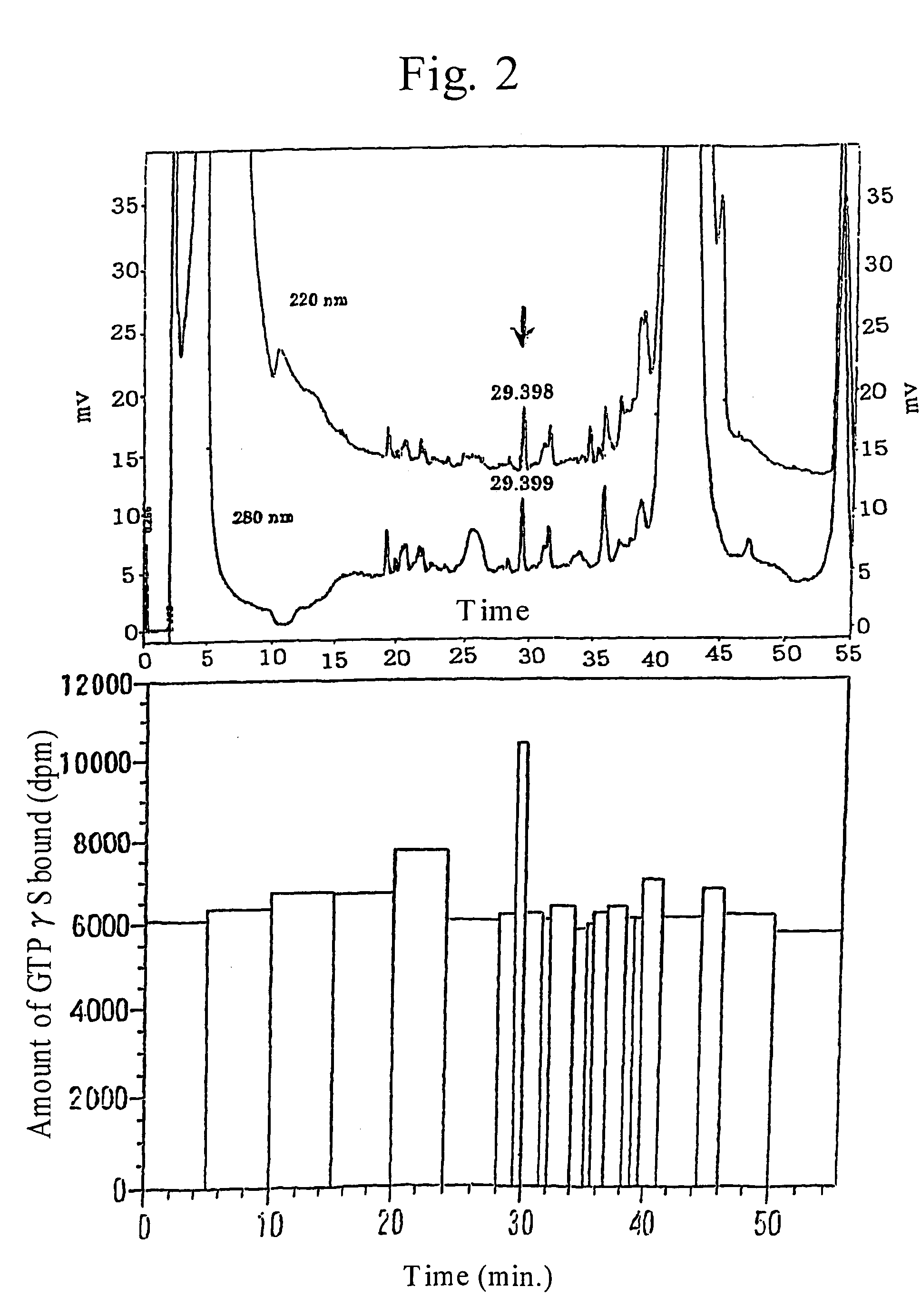Peptide having appetite stimulating activity
a peptide and appetite stimulating technology, applied in the field of brain-derived polypeptides, can solve the problems of many difficulties in research on ligands to orphan receptors, few examples to actually identify ligands to orphan g protein-coupled receptors, and unclear whether
- Summary
- Abstract
- Description
- Claims
- Application Information
AI Technical Summary
Benefits of technology
Problems solved by technology
Method used
Image
Examples
example 1
Amplification of Human GPR8 cDNA by PCR Using Human Brain-derived cDNA
[0639]Reverse transcription was performed by using random primers, in which human brain-derived poly(A) +RNA (Clontech Laboratories, Inc.) was used as a template. TaKaRa RNA PCR ver. 2.1 Kit was used for the reverse transcription. Next, amplification was carried out by PCR, in which the resulting reverse transcription product was used as a template and synthetic primers represented by SEQ ID NO: 1 and SEQ ID NO: 2 were used. The synthetic primers were constructed so as to amplify the gene in the region to be translated to its receptor protein was amplified, in which the recognition sequences of restriction enzymes were added to the 5′ and 3′ ends, respectively, so that the base sequences recognized by restriction enzymes ClaI and SpeI were added to the gene at the 5′ and 3′ ends, respectively. The reaction solution was composed of 5 μl of cDNA template, 0.4 μM each of the synthetic DNA primers, 0.8 mM dNTPs and 0....
example 2
Subcloning of the PCR Product to Plasmid Vector and Confirmation of the Amplified cDNA Sequence by Decoding the Base Sequence of the Inserted cDNA Region
[0640]The reaction solution obtained by PCR in EXAMPLE 1 was subjected to 0.8% low melting agarose gel electorphoresis for separation. The band parts were excised from the gel with a razor blade and ground to small pieces, which were then extracted with phenol / choloroform and precipitated in ethanol to recover DNAs. According to the protocol attached to PCR SCRIPT™ Amp SK(+) Cloning Kit (Stratagene), the recovered DNAs were subcloned into the plasmid vector, PCR-SCRIPT™ Amp SK(+) (a cloning vector derived from a phagemid including an ampicillin-resistance gene). The recombinant vectors were introduced into. Escherichia coli DH5α competent cells (Toyobo Co., Ltd.) to produce transformants. Then, clones having a cDNA-inserted fragment were selected in an LB agar culture medium containing ampicillin, IPTG and X-gal. Only clones exhibit...
example 3
Preparation of CHO Cells which Express GPR8
[0641]Using Plasmid Midi Kit (Qiagen), plasmid DNA was prepared from the E. coli clones transformed by the plasmid bearing the gene encoding the full-length amino acid sequence of human brain-derived GPR8, which sequence was confirmed in EXAMPLE 2, having the ClaI and SpeI recognition sequences added at the 5′ and 3′ ends, respectively. The plasmid DNA was digested with the restriction enzymes ClaI and SpeI to excise the insert DNA. The insert DNA was electrophoresed, then excised from the agarose gel with a razor blade, ground into small pieces, then extracted with phenol and with phenol / chloroform, and precipitated in ethanol to recover DNAs. The insert DNA was added to the animal cell expression vector plasmid pAKK0-111H (the same vector plasmid as pAKK01.11 H described in Hinuma, S., et al., Biochim. Biophys. Acta, 1219, 251–259, 1994), which was digested with ClaI and SpeI, followed by ligation using T4 ligase (Takara Shuzo Co., Ltd.) ...
PUM
| Property | Measurement | Unit |
|---|---|---|
| dissociation constant | aaaaa | aaaaa |
| temperature | aaaaa | aaaaa |
| temperature | aaaaa | aaaaa |
Abstract
Description
Claims
Application Information
 Login to View More
Login to View More - R&D
- Intellectual Property
- Life Sciences
- Materials
- Tech Scout
- Unparalleled Data Quality
- Higher Quality Content
- 60% Fewer Hallucinations
Browse by: Latest US Patents, China's latest patents, Technical Efficacy Thesaurus, Application Domain, Technology Topic, Popular Technical Reports.
© 2025 PatSnap. All rights reserved.Legal|Privacy policy|Modern Slavery Act Transparency Statement|Sitemap|About US| Contact US: help@patsnap.com



